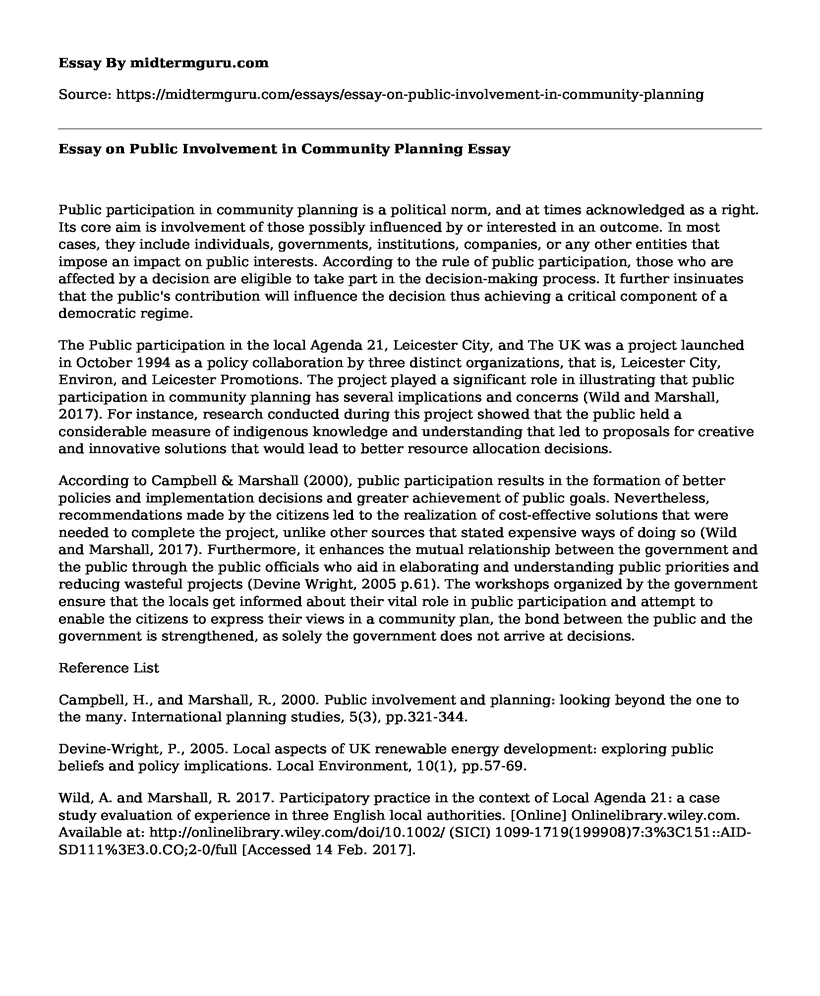Public participation in community planning is a political norm, and at times acknowledged as a right. Its core aim is involvement of those possibly influenced by or interested in an outcome. In most cases, they include individuals, governments, institutions, companies, or any other entities that impose an impact on public interests. According to the rule of public participation, those who are affected by a decision are eligible to take part in the decision-making process. It further insinuates that the public's contribution will influence the decision thus achieving a critical component of a democratic regime.
The Public participation in the local Agenda 21, Leicester City, and The UK was a project launched in October 1994 as a policy collaboration by three distinct organizations, that is, Leicester City, Environ, and Leicester Promotions. The project played a significant role in illustrating that public participation in community planning has several implications and concerns (Wild and Marshall, 2017). For instance, research conducted during this project showed that the public held a considerable measure of indigenous knowledge and understanding that led to proposals for creative and innovative solutions that would lead to better resource allocation decisions.
According to Campbell & Marshall (2000), public participation results in the formation of better policies and implementation decisions and greater achievement of public goals. Nevertheless, recommendations made by the citizens led to the realization of cost-effective solutions that were needed to complete the project, unlike other sources that stated expensive ways of doing so (Wild and Marshall, 2017). Furthermore, it enhances the mutual relationship between the government and the public through the public officials who aid in elaborating and understanding public priorities and reducing wasteful projects (Devine Wright, 2005 p.61). The workshops organized by the government ensure that the locals get informed about their vital role in public participation and attempt to enable the citizens to express their views in a community plan, the bond between the public and the government is strengthened, as solely the government does not arrive at decisions.
Reference List
Campbell, H., and Marshall, R., 2000. Public involvement and planning: looking beyond the one to the many. International planning studies, 5(3), pp.321-344.
Devine-Wright, P., 2005. Local aspects of UK renewable energy development: exploring public beliefs and policy implications. Local Environment, 10(1), pp.57-69.
Wild, A. and Marshall, R. 2017. Participatory practice in the context of Local Agenda 21: a case study evaluation of experience in three English local authorities. [Online] Onlinelibrary.wiley.com. Available at: http://onlinelibrary.wiley.com/doi/10.1002/ (SICI) 1099-1719(199908)7:3%3C151::AID-SD111%3E3.0.CO;2-0/full [Accessed 14 Feb. 2017].
Cite this page
Essay on Public Involvement in Community Planning. (2021, Jun 03). Retrieved from https://midtermguru.com/essays/essay-on-public-involvement-in-community-planning
If you are the original author of this essay and no longer wish to have it published on the midtermguru.com website, please click below to request its removal:
- Servant Leadership in Nursing Team
- Essay on Leadership in the Military Settingi
- Essay on Conflicts Between the Tibetans and the Han Chinese
- Research Paper on Supply And Demand for Global Air Transportation
- Paper Example on NRF, NIMS, and ICS
- Criminal Justice Policies: Theories, Ideologies & Ethical Issues - Essay Sample
- Leadership: Key to Success in a Competitive World - Essay Sample







